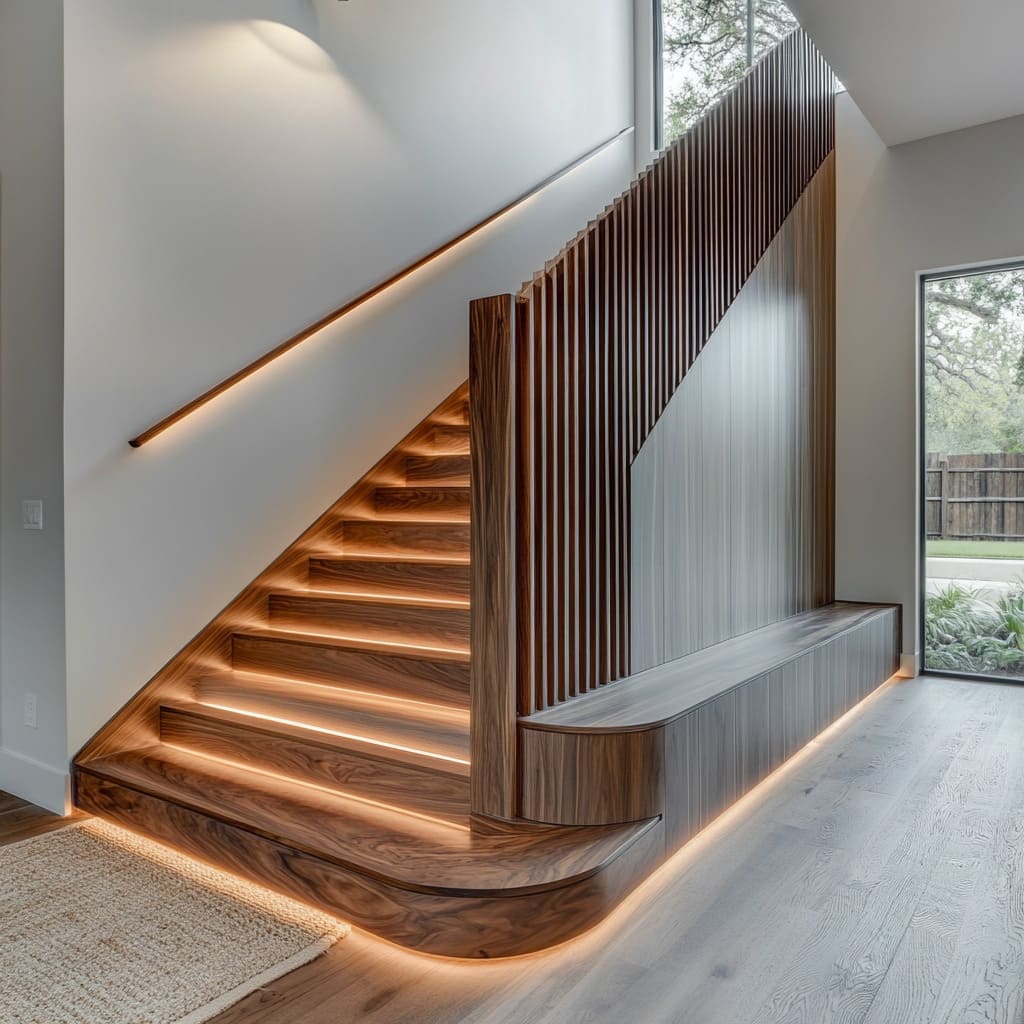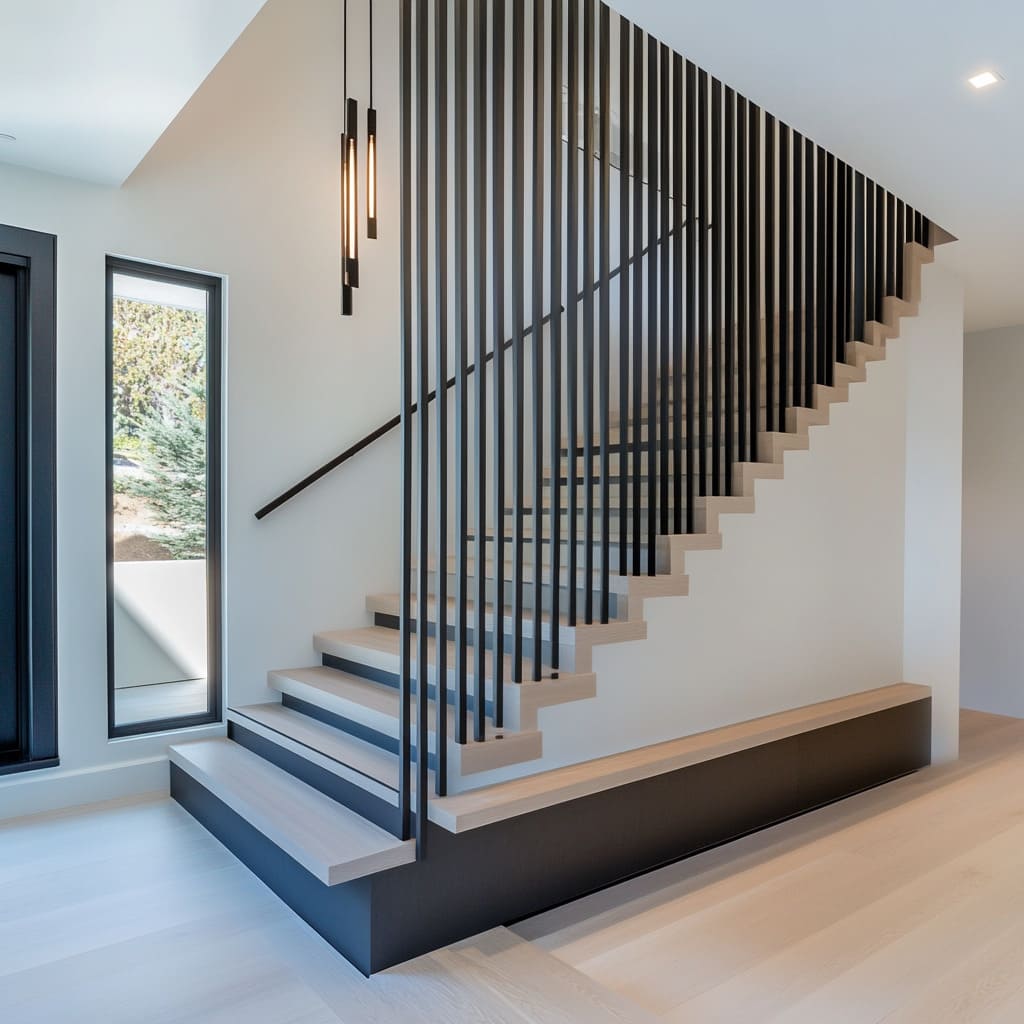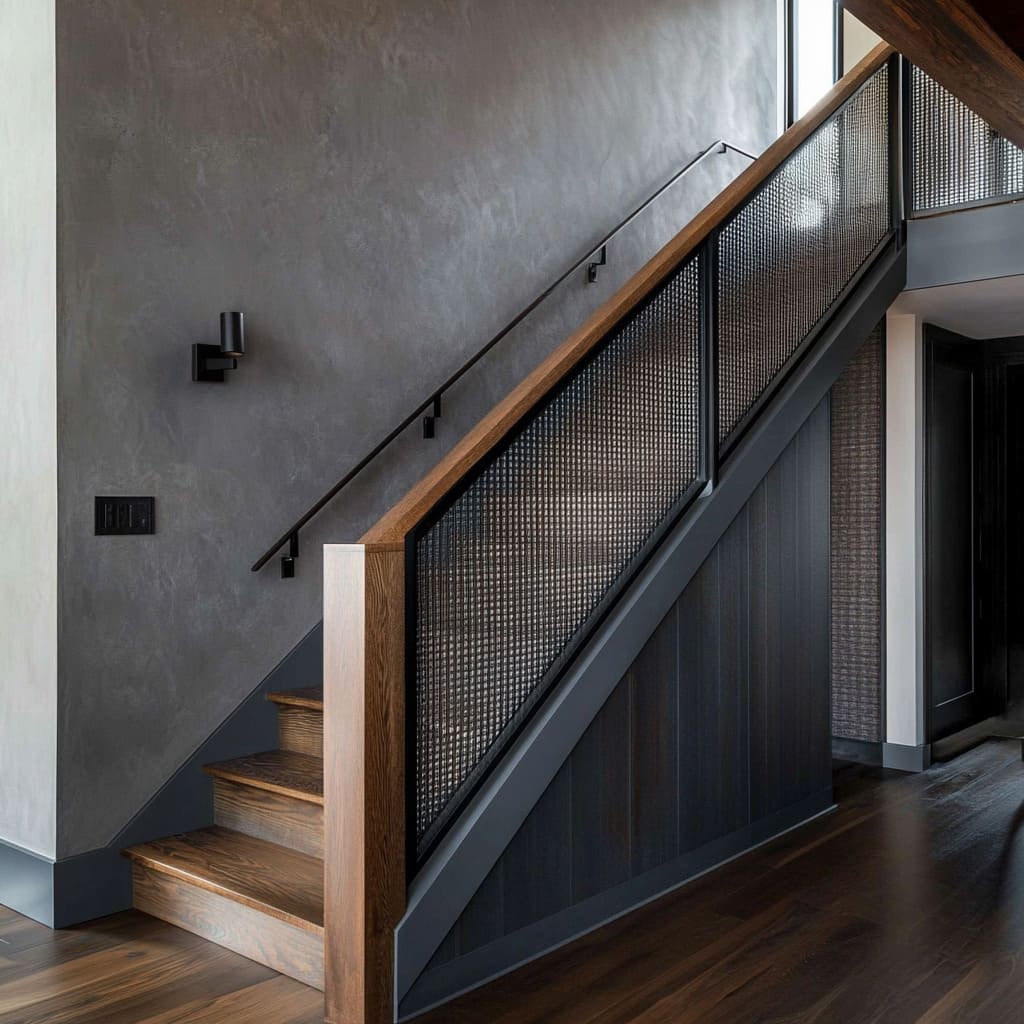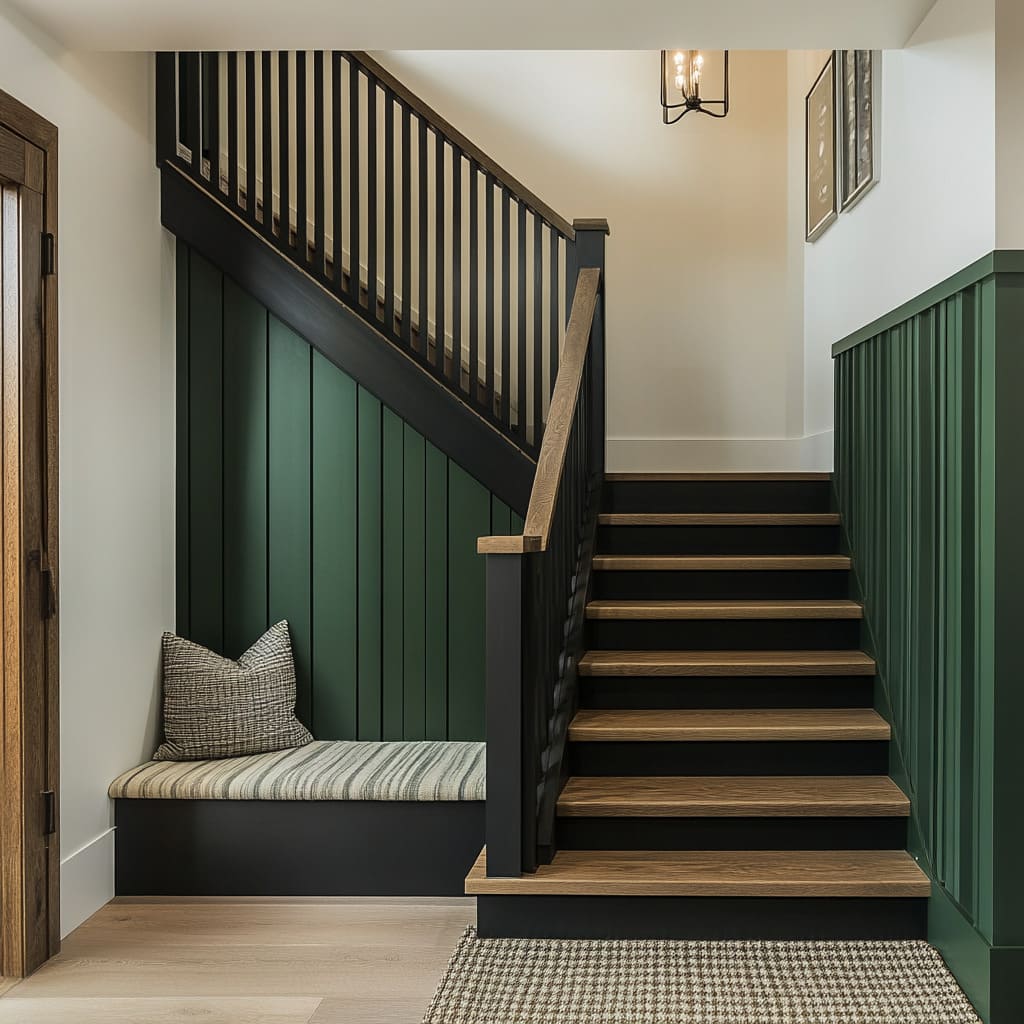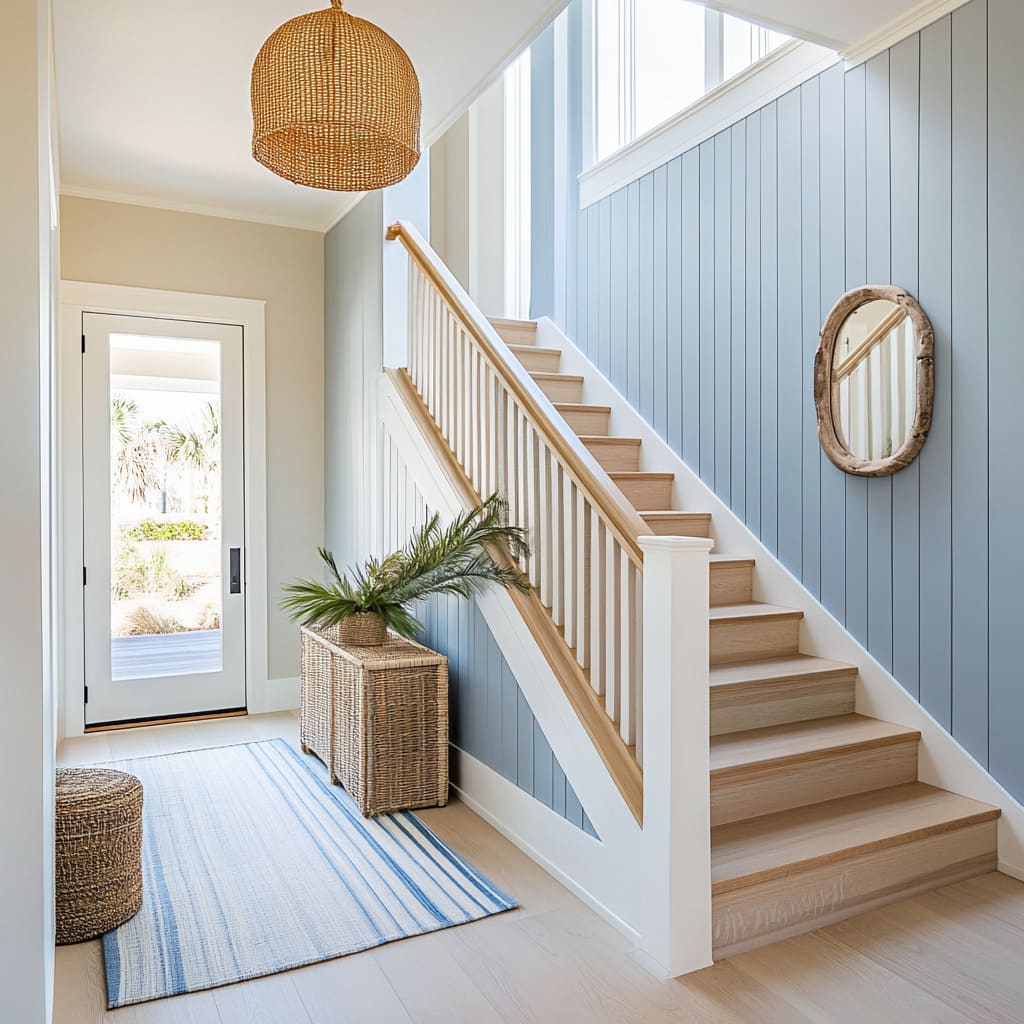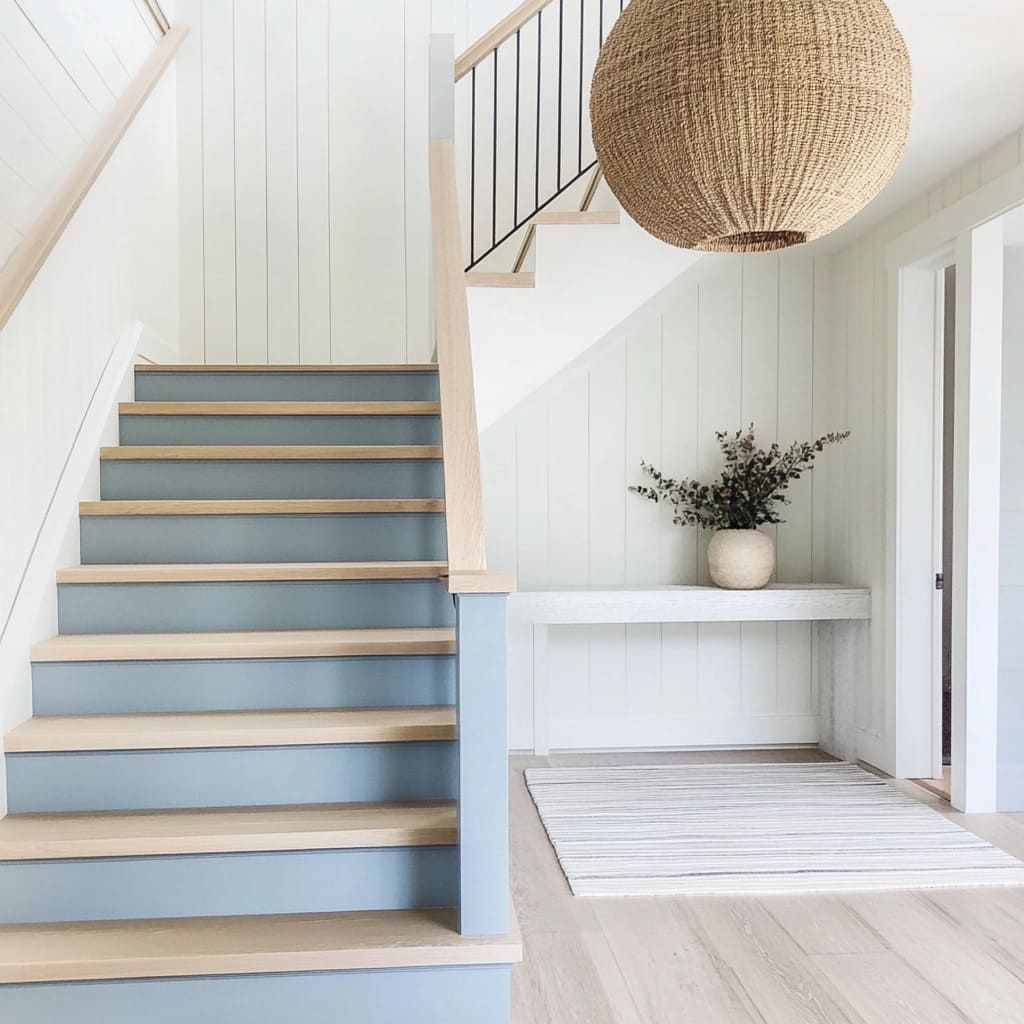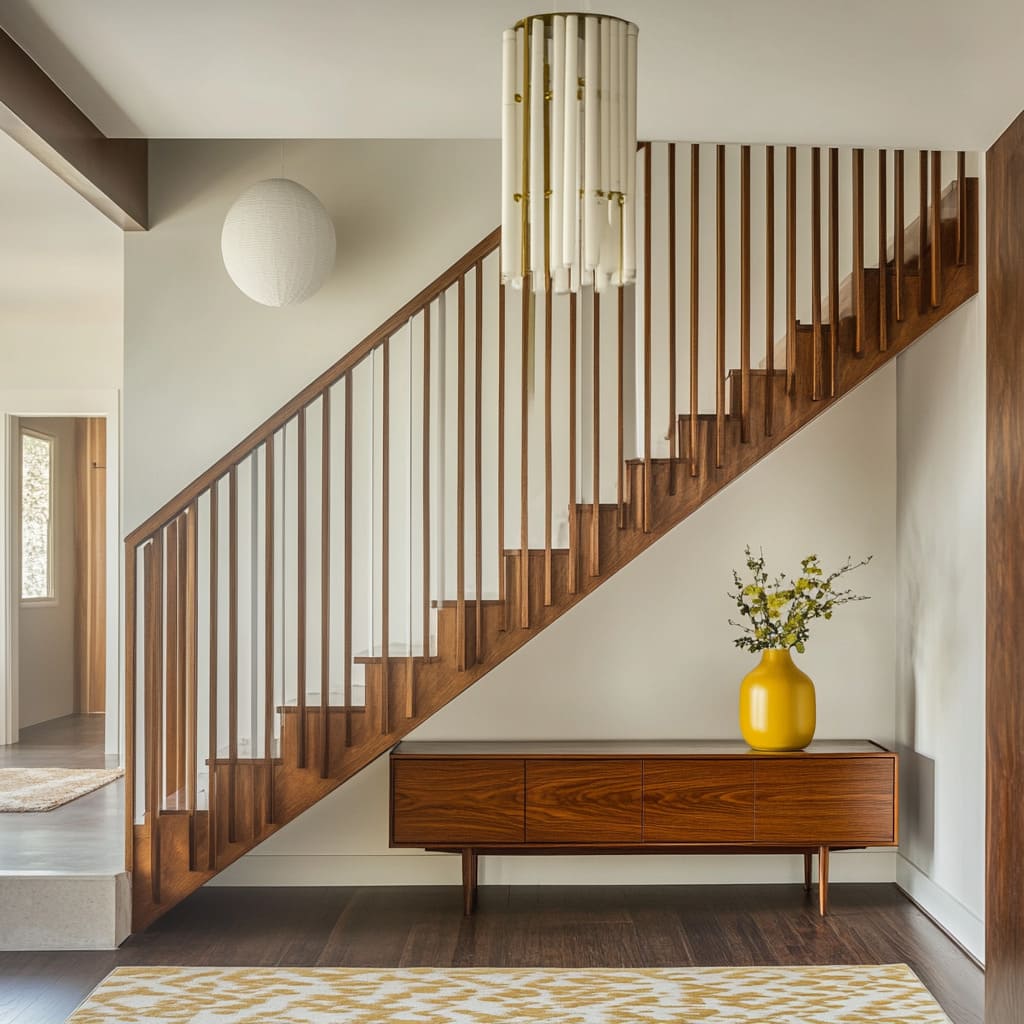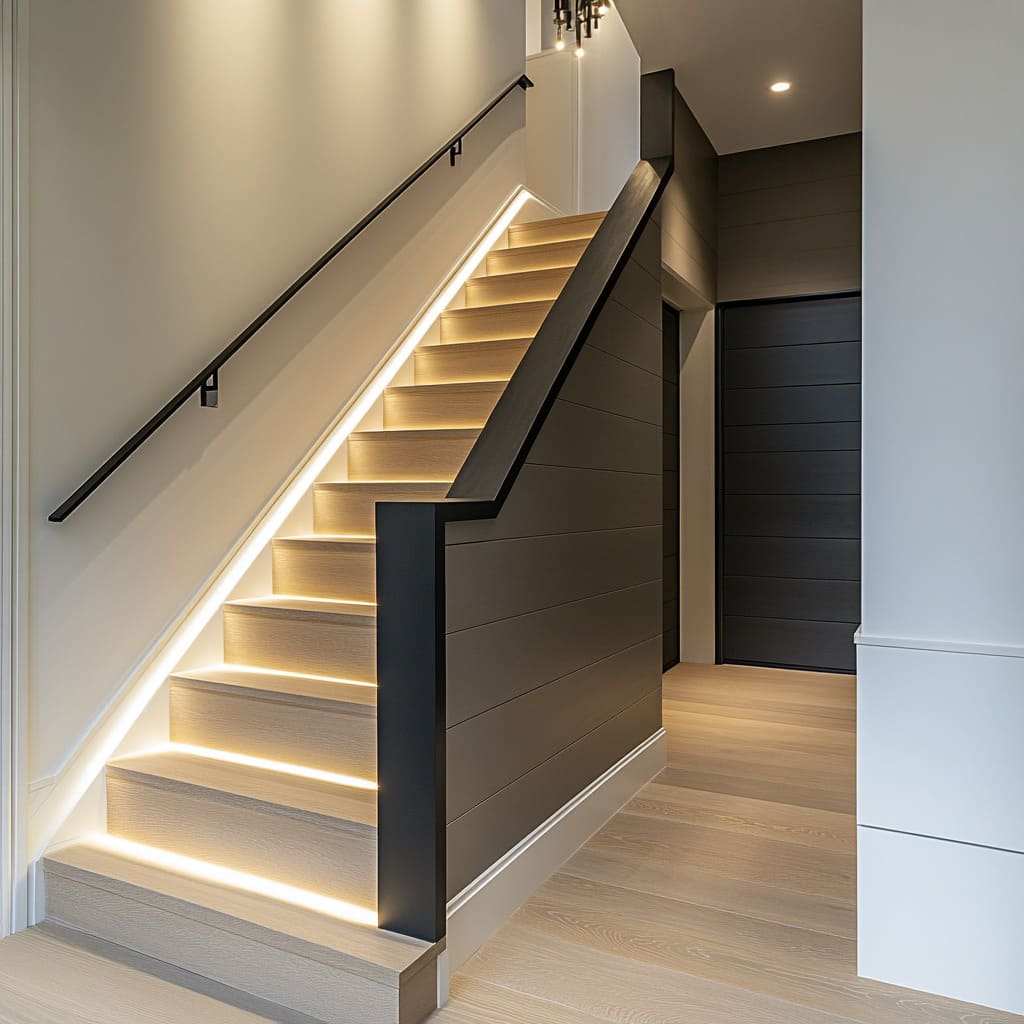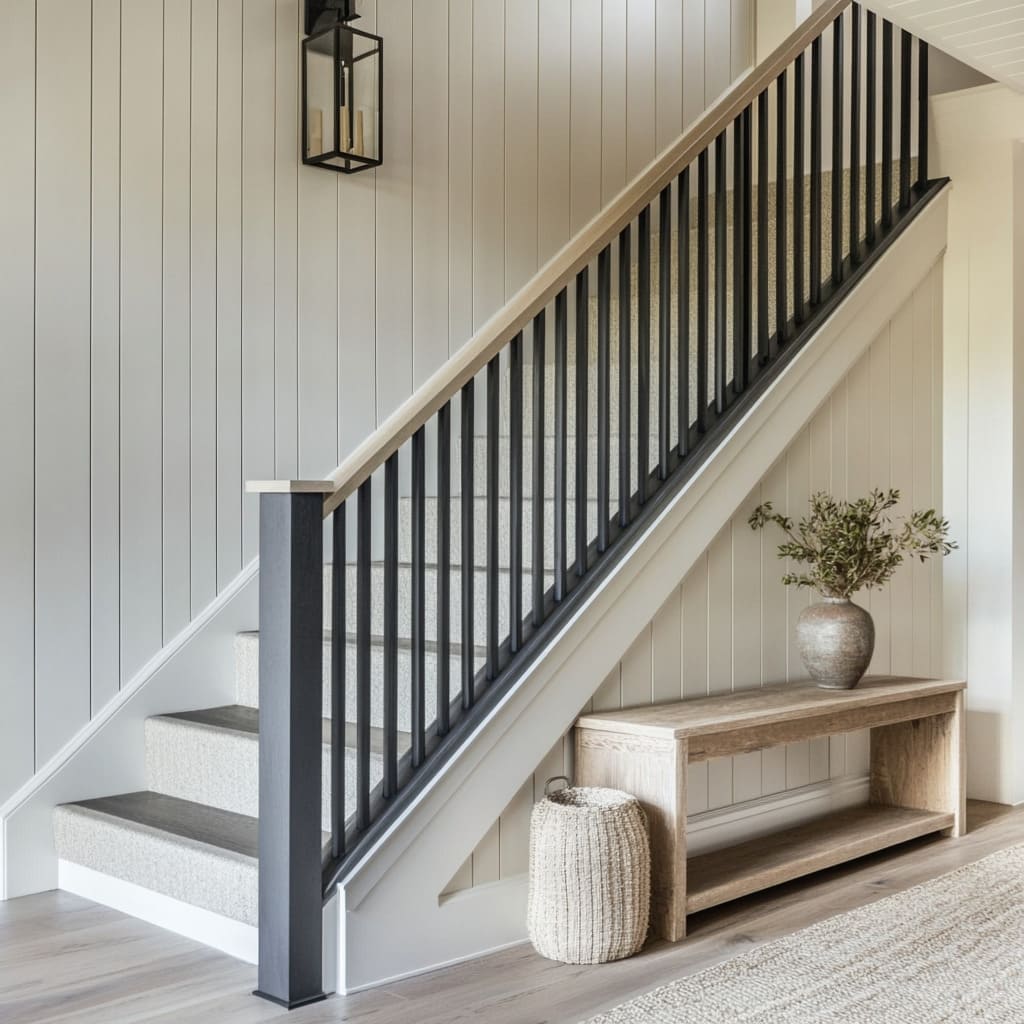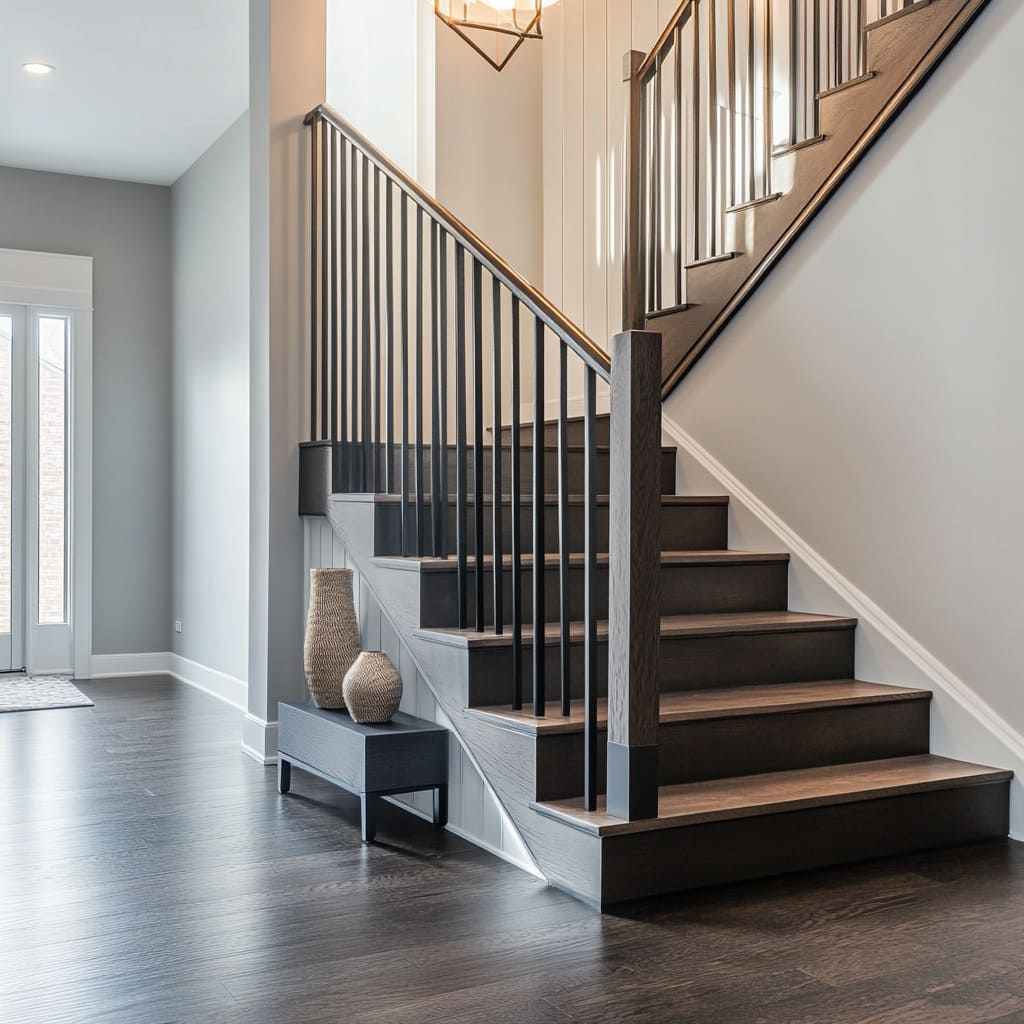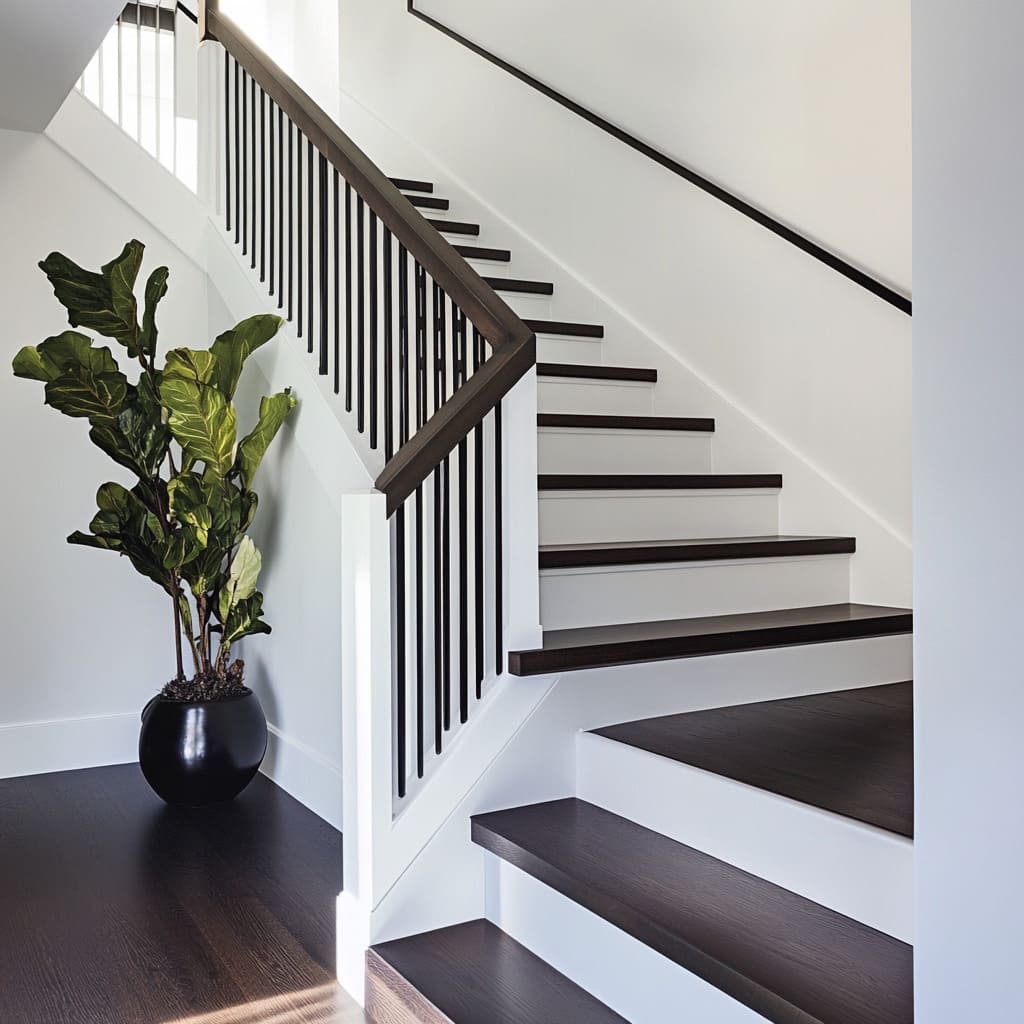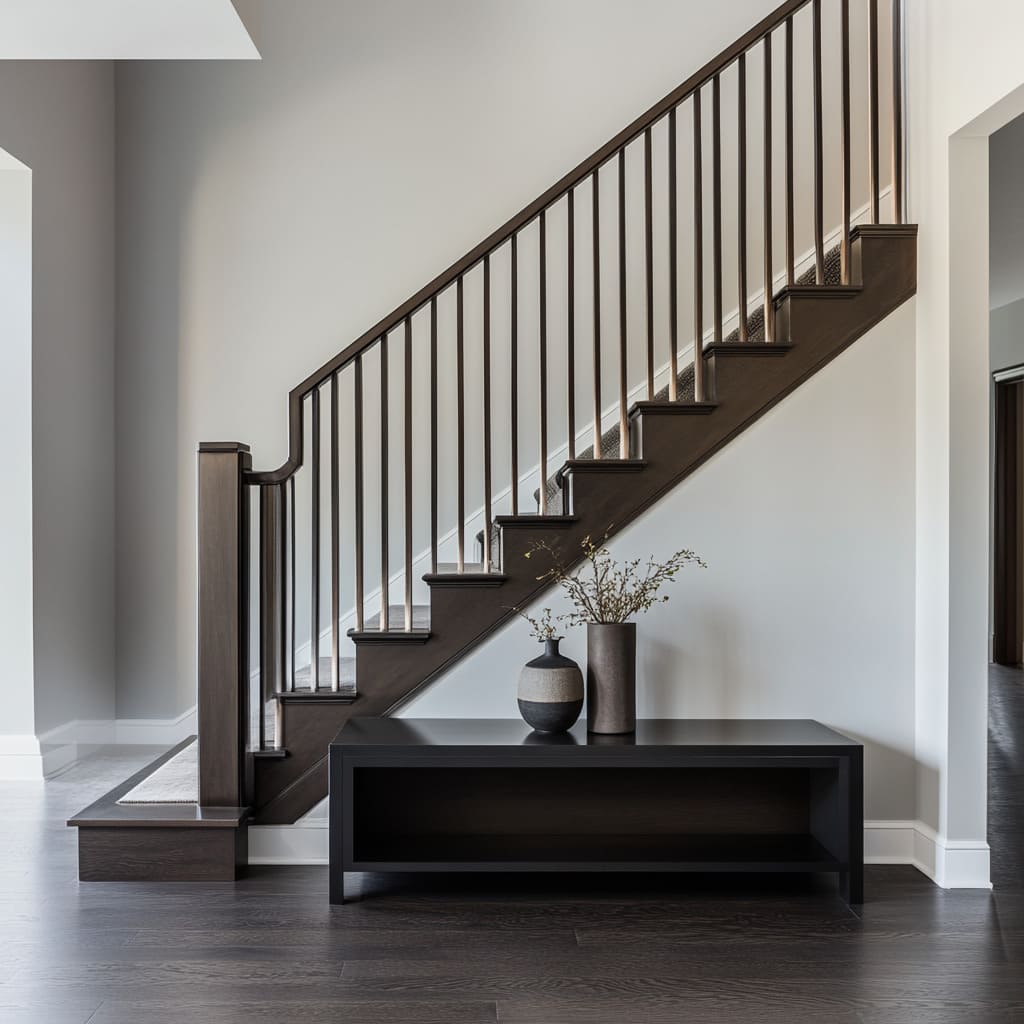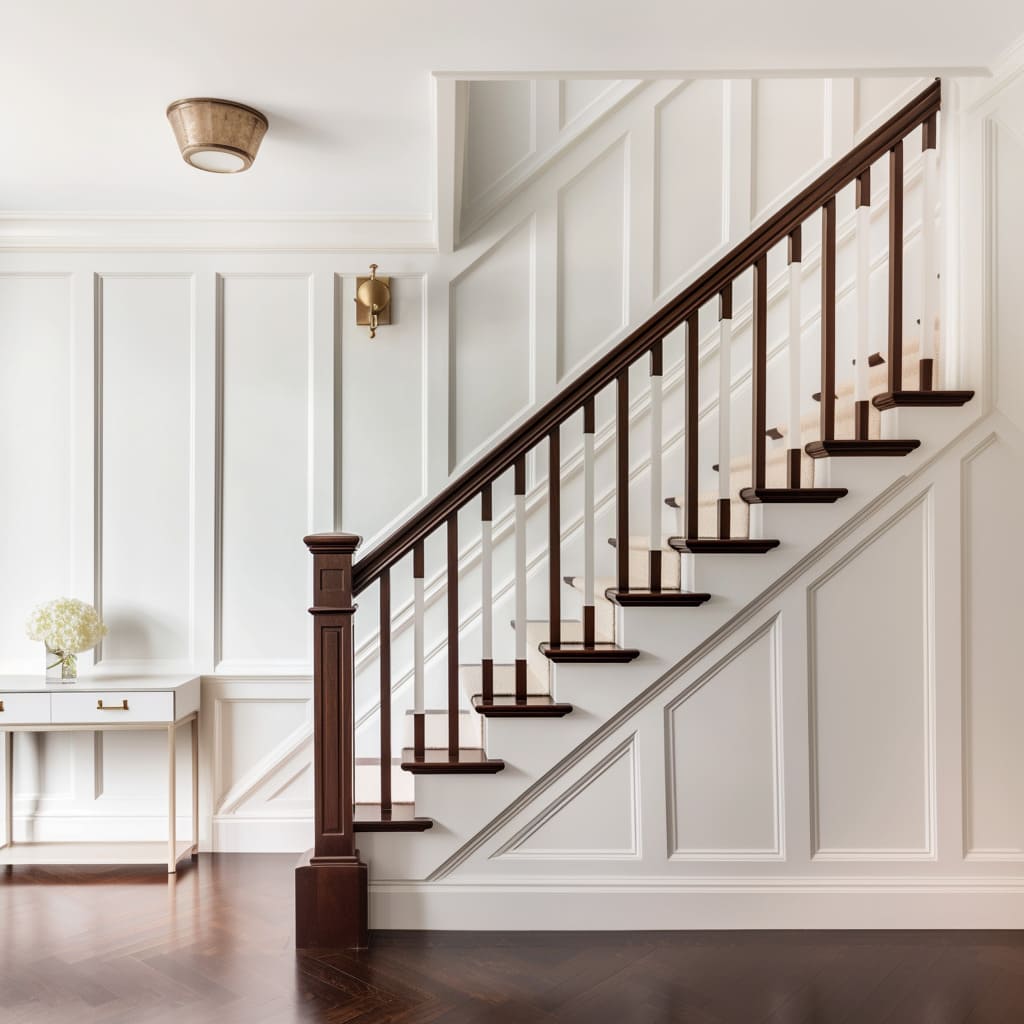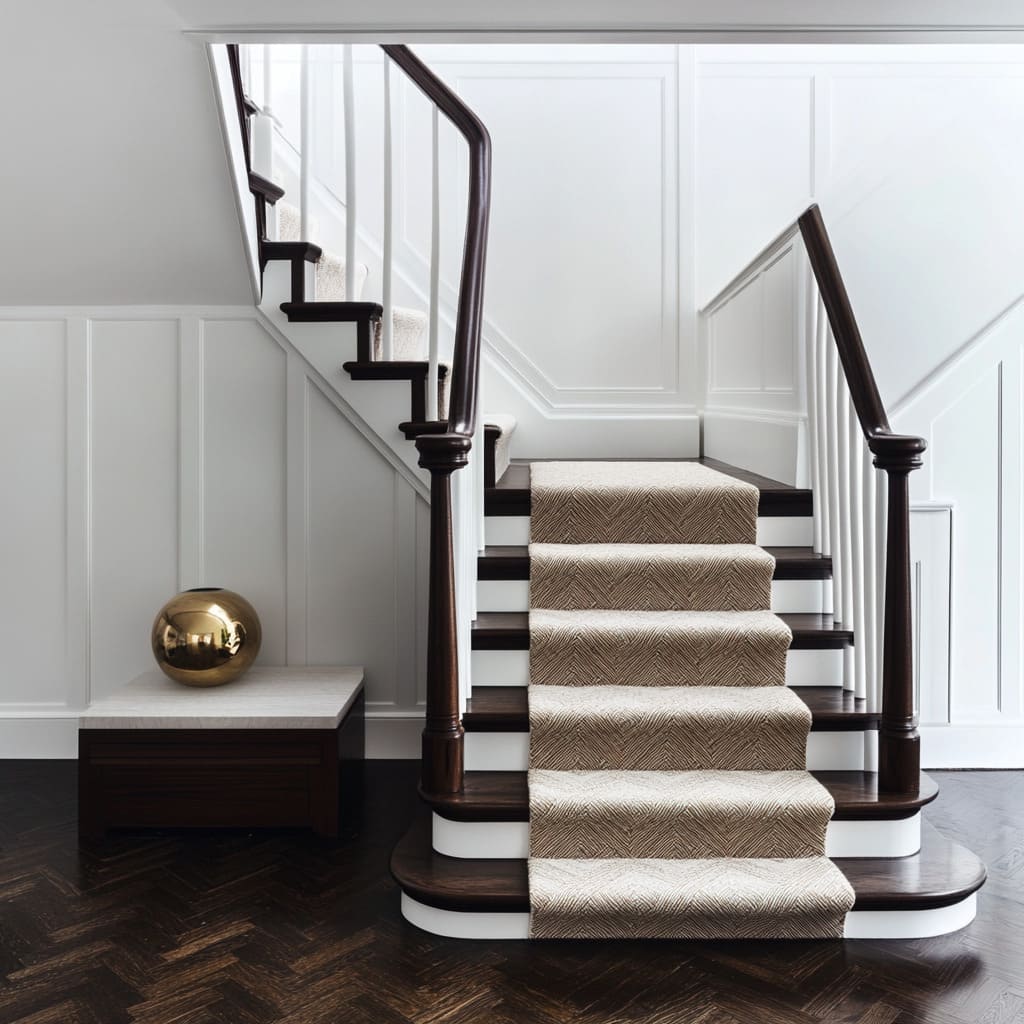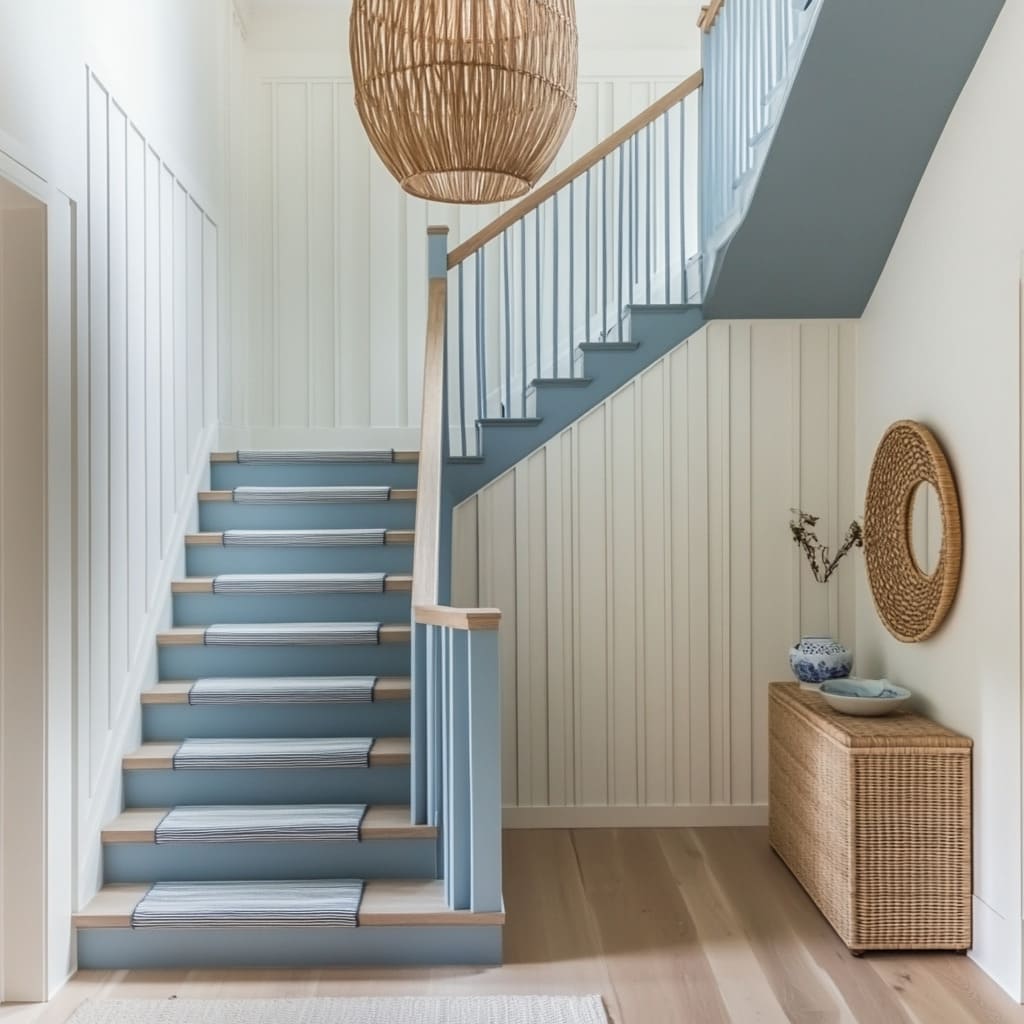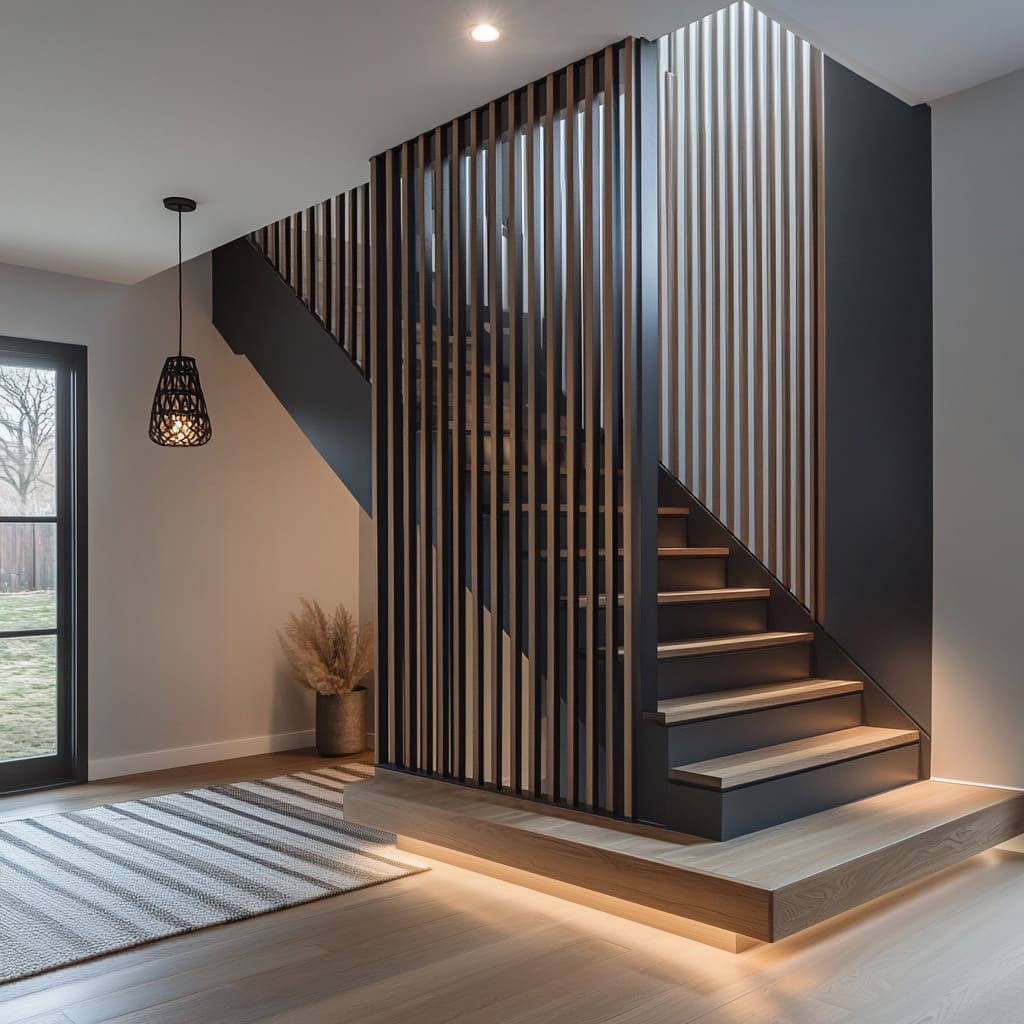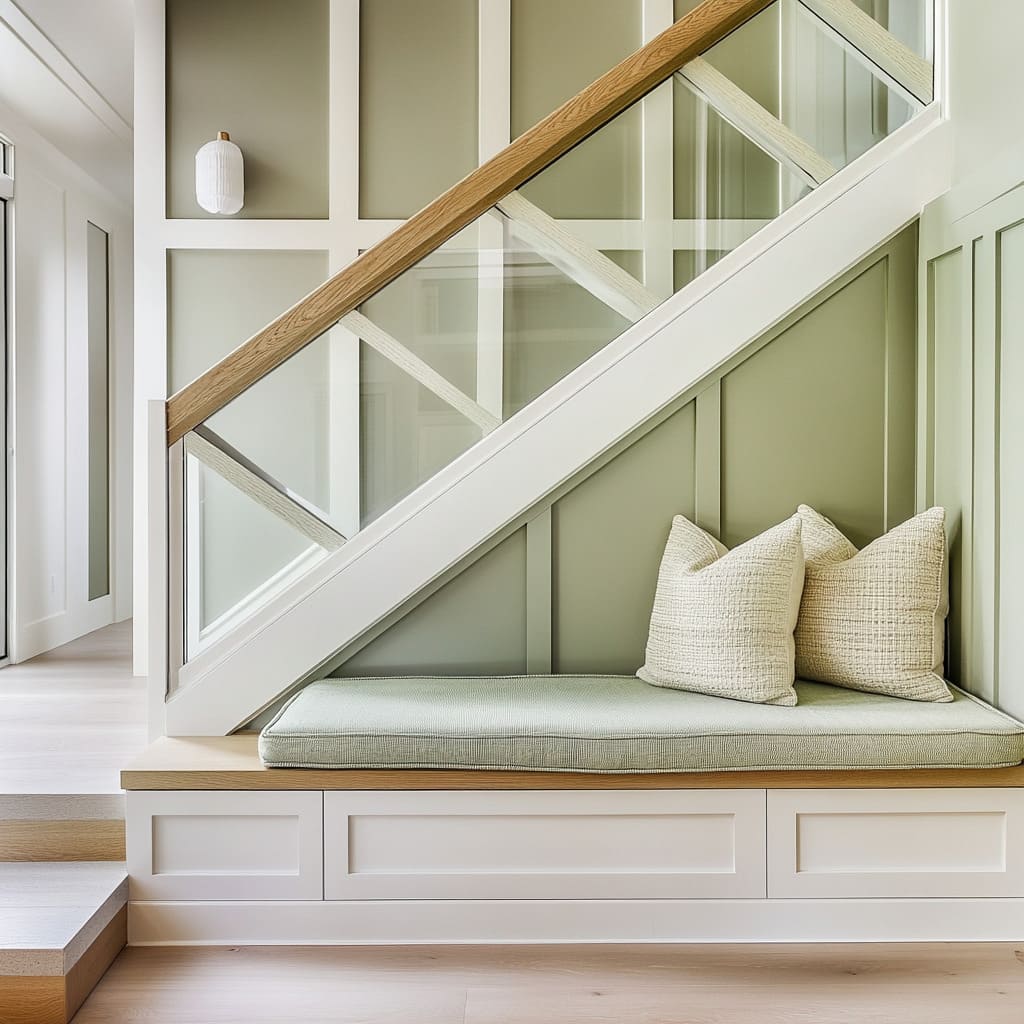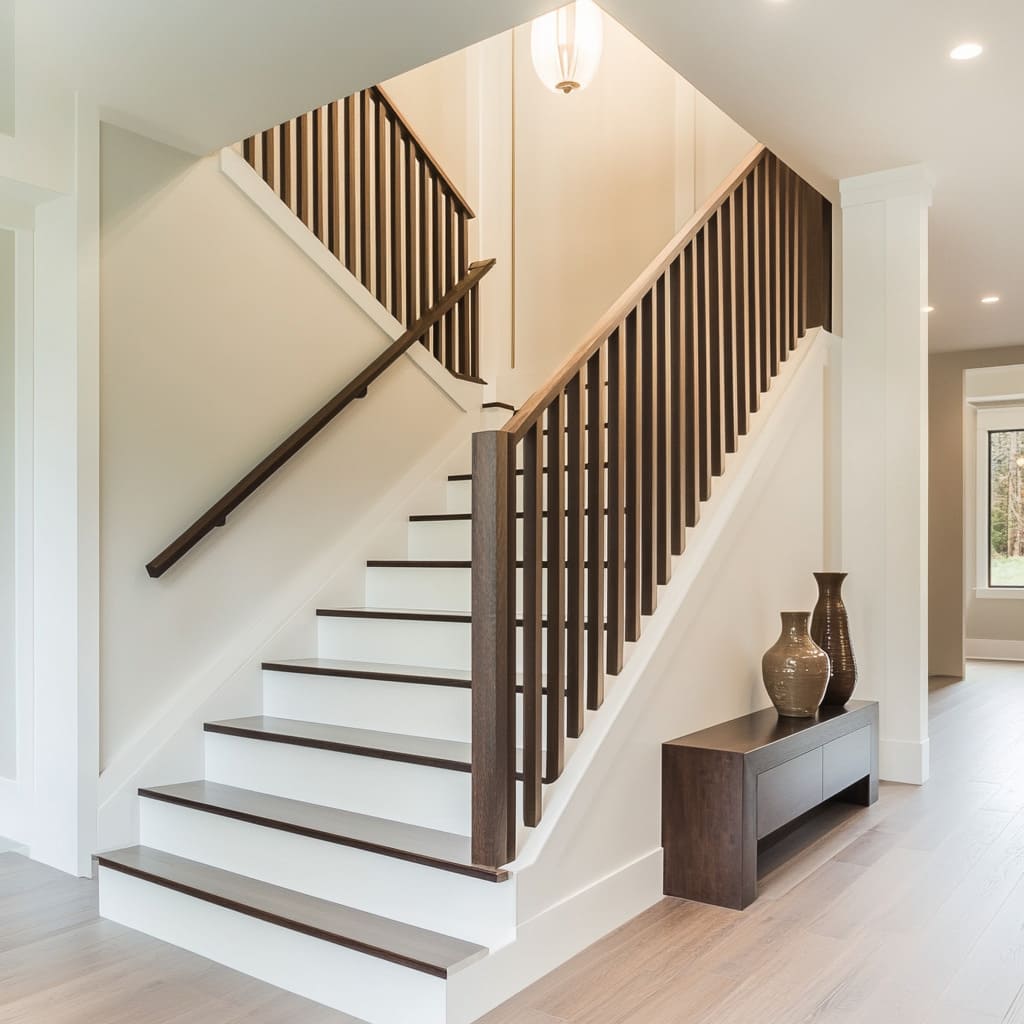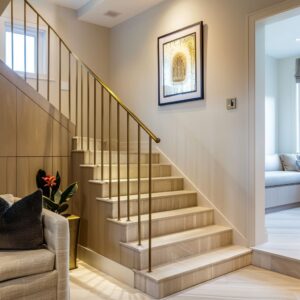Modern staircases are more than a way to move between floors—they shape the flow of a space, define its character, and set the stage for everything around them. The design of a modern wooden railing for stairs plays a key role in this, adding structure while influencing how light moves and how open or enclosed an area feels.
This article takes a closer look at the details that often go unnoticed but make a major impact. From the way materials interact to the subtle effects of color, geometry, and lighting, we’ll explore design choices that elevate staircases into statement features.
Whether it’s a sleek minimalist railing, a bold contrast between wood tones, or a sculptural element that doubles as a partition, small refinements can completely shift the look and feel of a space. By breaking down these ideas, this guide will give you a fresh perspective on stair railing design, whether you’re planning a new staircase or rethinking an existing one.
Multi-Layered Color Blocking and Subtle Gradients
Staircases are more than functional—they guide movement while shaping how a space feels. One of the most effective ways to refine their impact is through thoughtful color transitions, creating a visual rhythm that moves naturally through a home.
By adjusting how wood tones shift between the base and upper levels, designers can emphasize height, depth, and contrast without overwhelming the overall composition.
Floating Color Shifts
A staircase with carefully planned color progression naturally draws the eye upward. One approach is to start with deeper wood tones at the lower steps and gradually transition to lighter hues as the staircase ascends.
This effect makes the upper landing feel more open while grounding the structure below. Some designers flip this idea, using lighter treads near the base while introducing richer wood stains as the steps rise.
This technique works especially well when the staircase leads to a hallway with bright flooring, ensuring the darker tones frame the transition. The effect is subtle but impactful, adding movement and refining how light interacts with the space throughout the day.
Complex Neutrals
Dark espresso, charcoal, and deep walnut stains often appear as singular shades at first glance. In reality, their undertones—whether warm, cool, or neutral—shift significantly depending on the surrounding environment.
Lighting, paint color, and adjacent materials can either intensify or soften these tones, affecting the overall balance of the staircase. Pairing cooler dark wood treads with slightly warm-toned wall colors prevents an overly stark contrast, allowing the materials to complement rather than compete.
Likewise, blending a reddish-brown wood with cool-toned grays creates a subtle tension that adds depth. This attention to nuance ensures that the staircase integrates smoothly into the broader interior rather than feeling like a separate, disconnected element.
Layering for Depth
Creating clear visual boundaries between the different components of a staircase makes it more defined and intentional. A strong contrast between the treads, risers, and stringers establishes clean lines that enhance the structure’s overall shape.
When risers match the adjacent walls, the staircase appears more fluid, almost as if it were carved from the same surface. For those who prefer a bold, architectural look, introducing darker stringers alongside lighter treads can make the steps appear more sculptural.
This technique works particularly well with modern wood balusters, as their vertical lines reinforce the contrast and provide extra structure to the design. By layering colors carefully, whether through gradients, undertones, or high-contrast combinations, a staircase becomes more than a transition point—it becomes a key design feature that subtly influences the entire flow of a home.
Strategic Use of Transparency and Semi-Transparency
Staircases are often seen as solid structures, but the right balance of transparency can make them feel lighter, more open, and better connected to the surrounding space. Whether through glass, mesh, or carefully spaced wood elements, introducing semi-transparent features keeps the staircase functional while reducing its visual weight.
Glass Panels with Wood Framing
A wooden railing design for a staircase framed with glass panels creates a sleek yet natural effect, offering support while maintaining openness. Unlike traditional vertical balusters, glass extends the line of sight, allowing light to move freely and making the entire staircase feel less enclosed.
One way to enhance this idea is by incorporating wood-framed glass panels with subtle detailing. Instead of a plain sheet, adding an X-shaped pattern or narrow overlays creates depth while keeping the structure visually light.
This approach works particularly well in homes with a mix of modern and rustic influences, as the warmth of wood balances the crisp clarity of glass. For those who prefer a more understated look, a minimalist glass panel railing with a thin wooden handrail blends into the surroundings while still providing safety.
This design is especially effective in staircases positioned near large windows, allowing natural light to flow seamlessly through the space.
Textured Mesh Inserts
Breaking away from traditional railings, horizontal mesh panels offer a fresh take on transparency. Unlike open balusters, mesh creates a layered effect, filtering light and adding an industrial or contemporary edge.
The texture of the mesh plays a big role in its impact. A fine, tightly woven pattern allows for a semi-transparent effect, softening the look while still keeping the structure secure.
On the other hand, a more open, grid-like mesh lets in more light and creates interesting shadows throughout the day, subtly shifting as natural light moves through the space. This style works well in modern lofts, urban-inspired interiors, or homes that blend wood, metal, and neutral tones.
When paired with a deep-stained wooden handrail, mesh inserts can take on a more refined look, preventing them from feeling too industrial. By integrating glass or mesh into stair railings, a staircase becomes more than just a passage between floors—it becomes a key architectural feature that enhances flow, light, and visual openness.
Highlighting Wood Grain and Craftsmanship
Wood brings warmth and authenticity to any staircase, but the way it’s crafted can make all the difference. A modern wood railing isn’t just about structure—it showcases the artistry of fine materials, where every detail, from grain alignment to seamless connections, plays a role in the final look.
Thoughtful design choices can transform railings into architectural features that feel as refined as they are functional.
Continuous Slats as a Feature Wall
Vertical wooden slats that extend from stair tread to ceiling do more than provide safety—they act as a sculptural partition that subtly defines the space. When the wood grain flows seamlessly across each slat, it creates a rhythm that draws the eye upward, emphasizing height while keeping the design cohesive.
The impact of this approach depends on the wood selection and grain direction. A straight-grain walnut or oak delivers a clean, modern look, while more expressive grain patterns add movement and texture.
The way slats are spaced also affects how light filters through—tight spacing creates a more solid boundary, while wider gaps allow for a lighter, more open effect. This style works especially well in open-concept homes, where staircases need to feel connected to the surrounding space rather than isolated.
The vertical slats provide just enough separation without blocking views, making them a practical and visually striking choice.
Recessed or Hidden Hardware
Exposed fasteners and bulky brackets can take away from the natural beauty of wood, which is why many modern staircases rely on concealed connections to maintain a smooth, uninterrupted surface. When a handrail is embedded into the railing or attached with discreet, recessed hardware, it lets the material take center stage.
This technique demands precision, as the joints must be crafted to hold weight without visible support. The result is a seamless transition between the railing, balusters, and steps, reinforcing the sense of craftsmanship.
For homeowners or designers who appreciate clean lines and minimalism, recessed hardware is a subtle but powerful way to refine a staircase. Paired with wood species that showcase rich grain patterns, the absence of visible fasteners allows the natural beauty of the material to stand out.
A staircase should feel like an intentional part of the home’s design, and highlighting grain patterns, smooth connections, and carefully placed slats brings out the depth and richness of wood in a way that’s both practical and visually compelling.
Interplay of Light and Shadow
Light can change the way a staircase feels, shifting its appearance throughout the day and adding a sense of depth that goes beyond just form and function. A modern wood stair railing design can take advantage of natural and artificial lighting to create dynamic visual effects, making shadows an intentional part of the composition.
By playing with contrast, direction, and intensity, the railing itself becomes an evolving design element rather than just a static structure.
Layered Shadows with Slatted Railings
When a staircase features thin vertical slats or spindles, each one interacts with light in a unique way, producing shadows that move as the sun changes position. In homes with large windows or skylights, these shifting patterns can animate the space, adding a layer of visual interest without introducing extra materials or ornamentation.
Dark wood tones enhance this effect, as deeper colors create stronger shadows, making the railing feel more sculptural. Lighter wood, on the other hand, softens the contrast and blends more naturally with surrounding elements.
The spacing of slats also matters—closely spaced vertical lines cast dense, rhythmic shadows, while wider gaps allow for a more open, airy feel. This technique works especially well in staircases that connect multiple floors in an open layout, allowing light from different levels to interact with the structure.
At night, the interplay shifts, as artificial lighting takes over and the contrast becomes even more pronounced.
Integrated LED Strips
Subtle, built-in lighting can transform the look of a staircase after dark, making the steps appear almost weightless. Hidden LED strips placed under treads or along the sides of the staircase enhance both safety and aesthetics, defining each step with a soft glow.
This effect is particularly useful in staircases without strong natural light, ensuring visibility while maintaining a clean, modern appearance. The color temperature of the lighting makes a difference—warm LED tones bring out the natural richness of wood, while cooler lights create a more dramatic contrast.
Some designs use a combination of warm LEDs under the treads and cooler recessed ceiling lights to establish a balanced, layered effect. Beyond function, these lighting choices contribute to the overall atmosphere of a home.
A staircase illuminated with soft, indirect light becomes an inviting focal point, blending seamlessly into its surroundings while still making a statement. By considering how light interacts with materials, a railing can go beyond structural necessity and become a dynamic part of the design.
Incorporating Functional Elements (Benches, Consoles, and Storage)
A staircase isn’t just a transition between floors—it can also serve as a functional feature that enhances everyday convenience. Thoughtfully integrating seating, storage, or display areas into the design makes the most of the available space while keeping everything visually cohesive.
Whether through a built-in bench that follows the stair line or a console table that tucks neatly beneath open risers, these additions provide both practicality and style.
Benches That Extend Stair Lines
A bench that flows directly from the staircase structure doesn’t just add extra seating—it strengthens the architectural presence of the design. When the bench shares the same wood tone, grain direction, or alignment as the steps, it feels like a natural extension rather than a separate piece of furniture.
This approach works especially well in open-concept interiors, where staircases double as partitions between different areas. The seamless transition from steps to seating softens the transition while keeping the space feeling connected.
A well-placed bench can also serve as a practical landing spot near an entryway, offering a place to put on shoes or set down bags. For a more refined look, benches can be paired with modern wood handrails for stairs that echo the same finish and design language.
This keeps the overall aesthetic unified while ensuring the staircase remains the focal point.
Console Tables Beneath Open Risers
Open-riser staircases create opportunities to use the space underneath in creative ways. One of the most effective solutions is to position a console table or built-in shelving directly beneath the steps.
When the console matches the stair treads or railing in color and finish, it feels like an intentional part of the staircase rather than an afterthought. This is particularly useful in compact foyers or narrow hallways, where every furnishing needs to be optimized.
The table can serve as a display surface for decorative objects, books, or storage baskets, making the entryway both stylish and practical. Another option is a floating console or low-profile storage unit, which keeps the area visually open while still providing a functional element.
Paired with the right lighting—such as a wall sconce or concealed LED strip—this setup enhances the sense of depth while making the most of the available space. By integrating benches and consoles directly into the staircase layout, the design becomes more than just a circulation path—it becomes an adaptable feature that adds to both form and function.
Mixing Metals with Wood in Railing Systems
Pairing wood with metal in stair railings creates a refined contrast that blends warmth with strength. Whether through slender vertical balusters, horizontal cables, or perforated panels, the right combination of materials enhances both structure and style.
Many modern wood railing designs integrate metal elements in a way that keeps the space feeling open while adding a touch of industrial or contemporary appeal.
Metal Balusters for Airy Strength
Slim, vertical metal rods bring stability without visual heaviness. Their minimalist profile allows the wood grain of the handrail and steps to stand out while still providing the necessary support.
This combination works especially well when the metal has a matte black, brushed steel, or satin finish, adding a refined contrast against the organic texture of wood. The interplay of materials also affects how light interacts with the railing.
A dark metal baluster against light oak treads emphasizes depth, while a brushed steel version reflects ambient lighting, creating a softer effect. In homes with modern or transitional interiors, this pairing feels timeless yet fresh, offering both durability and a clean aesthetic.
Horizontal Cables or Mesh for a Contemporary Twist
Moving beyond traditional vertical balusters, some designs incorporate horizontal cables or perforated metal panels for a distinctive, modern feel. Horizontal lines naturally draw the eye outward, making staircases appear wider—an especially useful trick in compact spaces.
Perforated metal mesh adds another layer of texture and transparency, filtering light while maintaining safety. The effect is particularly striking when combined with thick walnut or oak stair treads, as the wood’s rich tones soften the industrial edge of metal inserts.
This balance makes the design feel intentional rather than overly utilitarian. By integrating both wood and metal in strategic ways, stair railings can bridge different design styles—offering the warmth of natural materials while maintaining a strong, contemporary presence.
Thoughtful Geometry and Composition
A staircase is more than just a connection between floors—it’s a design feature that can define the flow and character of a space. The way wood, lighting, and structural elements interact plays a major role in how the staircase is perceived.
Whether through floating steps, integrated paneling, or striking material contrasts, thoughtful composition ensures that function and style work together.
Floating Illusions
One of the most striking techniques in staircase design is the floating step effect, where treads appear to hover without visible support. This is achieved by offsetting treads from risers or using open-riser configurations, allowing light to pass through and reducing the staircase’s visual weight.
The effect is even more dramatic when combined with strategic lighting. LED strips placed under treads or along the stair wall enhance the sense of weightlessness, subtly defining each step without bulky supports.
Darker risers can also intensify the illusion, making the lighter-colored treads stand out as if they are suspended in midair. This approach works particularly well in narrow stairwells or compact spaces, where the absence of solid risers keeps the design feeling open rather than closed off.
In homes with minimalist interiors, floating staircases add a sleek, architectural presence without overwhelming the space.
Integration with Vertical Panels
A staircase can feel more connected to the surrounding space when it is integrated with vertical wall panels. By continuing the same paint color or paneling treatment from the lower walls up through the staircase, designers create a sense of continuity that visually grounds the structure.
This technique works especially well when wooden treads stand out against a painted backdrop. The contrast highlights the natural grain of the wood, making the steps feel even more intentional.
For a more seamless look, panel lines can be aligned with the stair treads, reinforcing the staircase’s geometry while maintaining a clean and structured aesthetic. Paneling isn’t just for visual appeal—it also enhances the sense of enclosure and makes a staircase feel more like an architectural element rather than an isolated structure.
When paired with modern wood railing ideas, this approach results in a staircase that feels both integrated and distinctive, striking the perfect balance between function and design.
Texture and Materials Beyond the Obvious
A staircase isn’t just about structure—it’s also an opportunity to introduce unexpected textures and materials that add personality and depth. Whether through fabric elements, color treatments, or tactile materials, these details can shift the entire feel of a space without changing the core design.
Carpet Runners and Upholstered Details
Adding a textured runner or upholstered bench can soften the look of a staircase while making it more comfortable to use. A runner with subtle patterns or natural fiber textures can highlight the wood underneath, especially when its edges are left exposed.
The way a runner interacts with light is another subtle design move. A low-pile woven runner reflects light differently than a plush, matte-finish carpet, affecting the perception of depth and movement.
Even in a neutral color palette, a stair runner can break up a long span of wood, creating a more defined rhythm. Built-in upholstered seating along a staircase wall is another way to introduce softness, often blending seamlessly with a modern wooden staircase railing design.
This works particularly well in open-plan layouts where a stairway serves as both circulation and a seating nook.
Coastal and Rustic Inspiration
Color is another tool for shifting how a staircase feels. While natural wood tones dominate many staircases, incorporating coastal blues, soft sage greens, or warm terracotta hues on risers or paneling can introduce a breezy or earthy atmosphere.
These shades work particularly well when paired with textured wood finishes, enhancing a casual, inviting aesthetic. Subtle textural details like board-and-batten paneling, woven rattan light fixtures, or hand-forged metal accents can further refine the character of a stairway without requiring major changes.
A simple change in finish—such as using wire-brushed wood for a matte, textured effect—can add a layer of depth that makes the staircase feel more grounded in its surroundings. By mixing materials in unexpected ways, a staircase becomes more than a functional element—it becomes a carefully considered design feature that contributes to the home’s overall style.
Subtle Changes in Line Weight
The way staircases balance thick and thin elements can completely change how they feel in a space. While some designs lean into heavier treads and slim railings to create contrast, others extend vertical balusters from floor to ceiling, adding a sense of continuity and height.
These adjustments in line weight influence how open or enclosed a staircase appears without altering the core structure.
Balanced Thick Treads and Slim Railings
When stair treads are crafted from substantial wood slabs, the surrounding elements need to feel just as intentional. A blocky oak step, for example, pairs well with slender metal rods or thin-profile cables, keeping the overall look from becoming too visually dense.
Black steel spindles against natural wood create a striking contrast, maintaining structure without overpowering the design. The same balance applies to handrails.
A chunky wooden handrail with delicate supports ensures that the staircase remains grounded yet visually lightweight. This approach works especially well in homes that favor a blend of industrial and organic materials, allowing the strength of the structure to shine without feeling overbuilt.
Continuous Vertical Extensions
Balusters that extend from the floor all the way to the ceiling or an overhead beam go beyond their usual role of guarding stair edges. They function as a visual spine, connecting different levels of a home in a seamless flow.
This method is often seen in open-concept layouts, where the staircase needs to define a space without fully enclosing it. Using floor-to-ceiling wood slats instead of standard railings achieves a natural partition effect, subtly dividing areas while still allowing light and airflow.
When these elements match the color and grain of the stair treads, they create an uninterrupted line, reinforcing a sense of height and structure. By adjusting the balance of solid and slender components, staircases can shift between bold architectural statements and understated design features—proving that even the smallest tweaks in line weight can have a significant impact.
Color Contrast That Directs the Eye
Color plays a powerful role in shaping how a staircase interacts with the surrounding space. Whether through bold contrast or a more subtle shift in tone, the right color combinations can draw attention to architectural details, create a sense of movement, or turn the staircase into a focal point.
Dark Treads, Light Risers
The contrast between deep-stained treads and pale risers is a timeless approach, but the precise shades used can dramatically change the effect. A stark black-and-white scheme creates a bold, graphic look, while warmer neutrals—like ivory or soft greige—produce a more blended, inviting feel.
The way these colors interact with surrounding walls, trim, and flooring also matters. If the risers match the wall color, the steps feel like a natural extension of the space, making the wood treads stand out even more.
Conversely, if the risers are slightly darker than the walls, they create a subtle framed effect, defining each step while maintaining a cohesive look. The proportion of dark to light also plays a role.
Narrow, dark-stained treads against a light riser feel crisp and structured, while wider wooden steps with thin risers create a softer transition. These adjustments can influence whether the staircase feels like a sharp architectural statement or a quiet, integrated feature.
Bold Accent Colors
While natural wood tones and neutral colors are the foundation of most staircases, unexpected color choices can shift the entire atmosphere. Deep forest green, rich terracotta, or muted periwinkle on risers or spindles add personality without overwhelming the design.
A dark railing paired with muted-colored risers can create a layered, sophisticated look, particularly in homes that lean toward modern rustic or transitional styles. On the other hand, painting the stair paneling in a distinct color allows the staircase to feel like a statement piece while keeping the treads and handrails natural.
Even small changes—like a subtly contrasting trim along the edge of each step—can shape how the eye moves along the staircase. Whether through deep wood tones, crisp contrast, or carefully placed accent colors, strategic color choices can turn an everyday staircase into a refined and intentional design feature.
Final Thoughts
A staircase is more than a functional necessity—it shapes how a space feels and flows. Modern wooden stair railings do more than provide safety; they define the character of a home, influencing how materials, light, and form interact.
From the subtle shift in wood grain to the balance of thick and thin elements, every detail plays a role in how the design comes together. The choice to incorporate glass panels, slim metal accents, or integrated lighting can completely change the way a staircase blends into or stands out within an interior.
Even secondary details, like benches that extend from the stairs or storage seamlessly built into the structure, reinforce the thoughtful planning behind the design. The transition from step to flooring, the way handrails connect to surrounding surfaces, and the use of contrasting or tonal color schemes all contribute to the visual depth.
A staircase doesn’t have to be purely structural—it can become a feature that enhances the broader design of the home.

